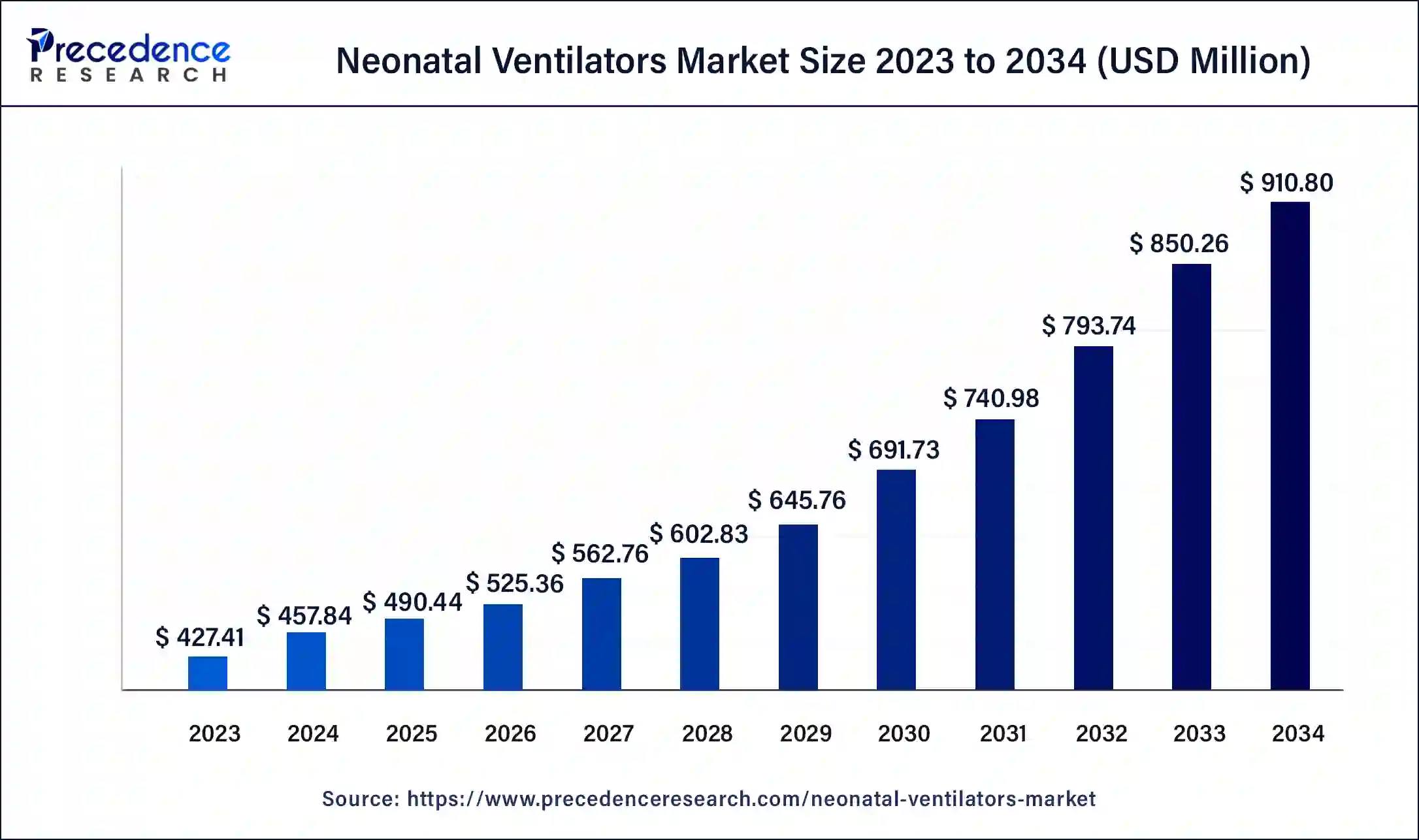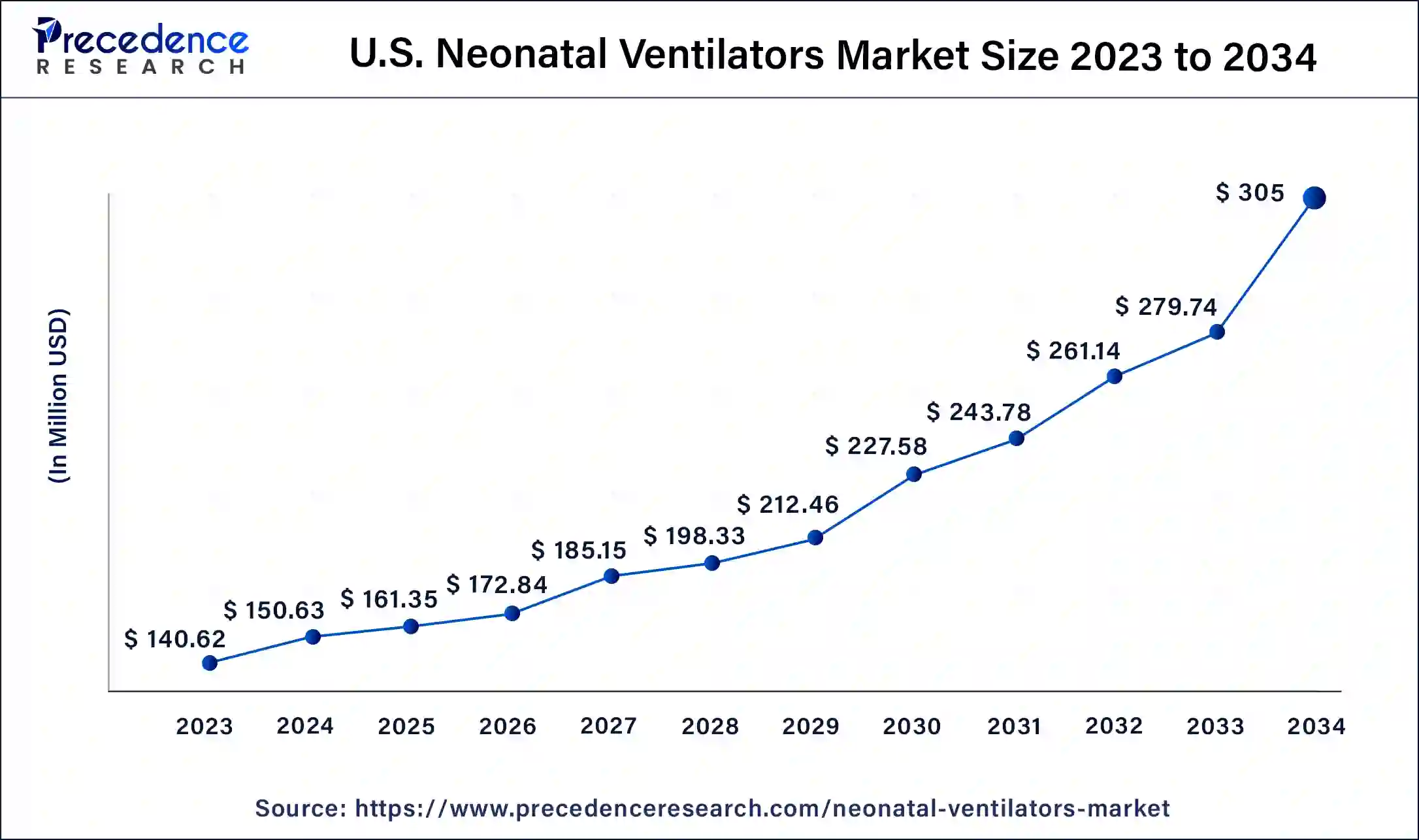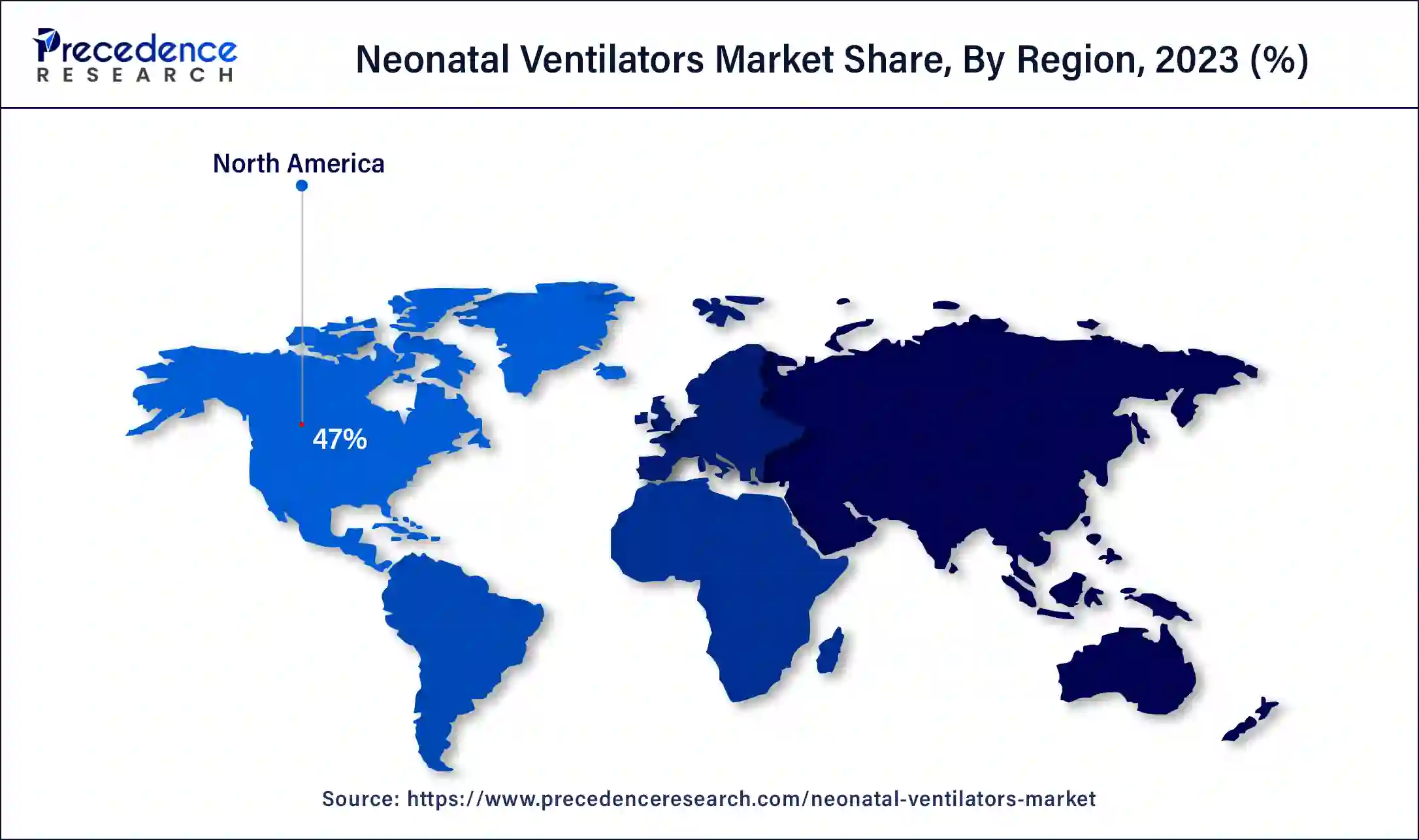September 2024
The global neonatal ventilators market size was USD 427.41 million in 2023, calculated at USD 457.84 million in 2024 and is expected to be worth around USD 910.80 million by 2034. The market is slated to expand at 7.12% CAGR from 2024 to 2034
The global neonatal ventilators market size is expected to worth USD 457.84 million in 2024 and is anticipated to reach around USD 910.80 million by 2034, growing at a CAGR of 7.12% over the forecast period 2024 to 2034.

The U.S. neonatal ventilators market size was reached at USD 140.62 million in 2023 and is projected to be worth around USD 305 million by 2034, poised to grow at a CAGR of 7.29% from 2024 to 2034.

North America dominated in the neonatal ventilators market in 2023. North America has a vast network of modern hospitals and newborn care units. Modern medical equipment, such as neonatal ventilators, essential for treating premature or seriously sick infants, is readily available in these clinics. In North America, preterm birth rates are comparatively high. Because they are necessary for the care of premature infants, neonatal ventilators are in greater demand in the area. Neonatal ventilator demand is further driven by funding for neonatal care programs and supportive healthcare policy.

Asia-Pacific is observed to be the fastest growing in the neonatal ventilators market during the forecast period. Asia-Pacific has seen significant infrastructure investment in the healthcare sector. Modern ventilatory support systems are necessary in neonatal intensive care units (NICUs). Hence, governments and commercial groups concentrate on improving these facilities. Technology is advancing quickly in the neonatal ventilator industry, creating increasingly complex and user-friendly equipment. Novelties like noninvasive and portable ventilators are becoming more and more common, especially in developing nations with inadequate infrastructure.
The industry that manufactures, distributes, and uses ventilators intended for newborns and infants, especially those born prematurely or with respiratory problems, is known as the neonatal ventilators market. To ensure sufficient oxygenation and ventilation to avoid or manage respiratory distress and other related issues, these ventilators provide artificial ventilation to supplement or replace the baby's natural breathing processes.
By providing precise control over breathing parameters, these devices enhance clinical results and lower the risk of long-term respiratory and neurological impairment in neonates. Specialized ventilators are in high demand within the medical device sector due to the increasing rates of premature births and respiratory problems in neonates. The use of neonatal ventilators is essential for improving the survival rates of premature and seriously sick infants.
How is AI helping the ventilator industry’s growth?
Artificial intelligence (AI) has been used in neurocritical care to develop automated seizure detection algorithms and severity grading systems for hypoxic-ischemic encephalopathy based on electroencephalograms. Furthermore, the advancement of assessing the growing newborn brain and comprehending how prenatal events influence structural and functional network topologies has been made possible by AI models that analyze magnetic resonance imaging. AI algorithms have also been used to evaluate preterm infants' extubation readiness and forecast the onset of bronchopulmonary dysplasia. Retinopathy of prematurity has also been identified, and the necessity of treatment has been established using automated models.
| Report Coverage | Details |
| Market Size by 2034 | USD 910.80 Million |
| Market Size in 2023 | USD 457.84 Million |
| Market Size in 2024 | USD 427.41 Million |
| Market Growth Rate from 2024 to 2034 | CAGR of 7.12% |
| Largest Market | North America |
| Base Year | 2023 |
| Forecast Period | 2024 to 2034 |
| Segments Covered | Product, Mobility, Technology, Mode, End-use, and Regions |
| Regions Covered | North America, Europe, Asia-Pacific, Latin America and Middle East & Africa |
Drivers
Rising incidence of premature births globally
Around the world, the number of premature births has been increasing because of several reasons, including changing lifestyles, advancing assisted reproductive technologies, and older mothers. Neonatal care equipment is in greater demand as healthcare advances and more pregnancies are actively followed, resulting in an increased identification and management of premature babies. The early identification of high-risk pregnancies, made possible by improved prenatal care and early detection procedures, necessitates the use of newborn ventilators and prompt interventions.
Rise in respiratory disorders in newborns
High-frequency oscillatory ventilation (HFOV) and synchronized ventilation are two sophisticated characteristics of modern neonatal ventilators that are essential for handling complicated respiratory disorders. These innovations meet newborn-specific demands, enhance patient outcomes, and propel market expansion. Worldwide, the number of neonatal intensive care units (NICUs) has significantly increased due to the rising prevalence of respiratory diseases. Due to this increase, neonatal ventilators and other specialist equipment are in high demand.
Inadequate healthcare infrastructure
There may not be enough neonatal intensive care units (NICUs) or other specialist institutions in areas lacking the infrastructure to provide for the needs of very sick babies. Since these hospitals are the primary consumers, the demand for newborn ventilators is limited. Distributing and maintaining neonatal ventilators might be logistically challenging in inadequate infrastructure. Inadequate supply chains and transportation networks can hamper the prompt delivery of these devices to areas in need.
Advances in neonatal care technology
EHR systems are becoming increasingly integrated with new newborn ventilators, enabling real-time data collecting and processing. This integration improves clinical decision-making overall and makes it easier to monitor patient progress and make timely adjustments to treatment regimens. Advanced alarm mechanisms on modern ventilators provide instant notifications when operating parameters depart from. These alerts guarantee timely reactions to altering patient situations and aid in averting possible complications.
The invasive ventilation segment dominated the neonatal ventilators market in 2023. Neonates experiencing severe respiratory distress or failure frequently require invasive ventilation, which entails endotracheal or tracheostomy tubes. Infants born prematurely or with congenital disabilities may have airway problems or underdeveloped lungs, which makes invasive support necessary to provide enough ventilation and oxygen. The significant training that healthcare practitioners receive in invasive ventilation techniques contributes to the increased use and acceptance of these devices. The knowledge found in NICUs further encourages the employment of invasive ventilation technology.
The non-invasive ventilation segment is observed to be the fastest growing in the neonatal ventilators market during the forecast period. Bilevel positive airway pressure (BiPAP) and continuous positive airway pressure (CPAP) are two examples of non-invasive breathing treatments that have gained popularity due to their many benefits. Among these advantages is a lower chance of intrusive procedure-related problems, including lung damage or infections. The use of NIV is growing as more healthcare providers become aware of these benefits.
Research has indicated that non-invasive ventilation can improve neonatal clinical outcomes, such as a decreased risk of bronchopulmonary dysplasia (BPD) and associated problems. As a result, NIV is now preferred for treating respiratory ailments, which has helped it expand in the market.
The intensive care ventilators segment dominated the neonatal ventilators market in 2023. Enhanced safety measures and advanced monitoring are vital for the management of critically ill newborns using intensive care ventilators. These include automated ventilation optimization modifications, alert systems, and real-time respiratory parameter monitoring. Accurate and timely care is crucial for infants with complicated medical issues, and these aspects help with that.
The portable/transportable ventilators segment shows notable growth in the neonatal ventilators market during the forecast period. Global preterm birth rates are rising, which is driving up demand for sophisticated neonatal care. These babies' breathing demands must be met, especially in an emergency or while being transported, and portable ventilators are crucial. The need for portable ventilators has increased due to establishing more neonatal intensive care units (NICUs) and specialized newborn transport services. To handle a range of clinical circumstances, these institutions frequently need different ventilatory support options, including portable models.
The high frequency ventilators segment dominated the neonatal ventilators market in 2023. In contrast to traditional ventilators, high-frequency ventilators (HFVs) provide fast, small-volume breaths at high frequencies, usually between three and fifteen breaths per second. This high-frequency breathing offers sufficient respiratory support for infants, particularly those with severe respiratory distress or diseases such as Neonatal Respiratory Distress Syndrome (NRDS). Because of the tiny, regular breaths that reduce stress on the developing lungs of neonates and enhance gas exchange, HFVs are especially useful in treating severe respiratory disorders.
The mechanical ventilators segment shows notable growth in the neonatal ventilators market during the forecast period. Globally, preterm birth rates are rising, which is driving up the need for neonatal care. Mechanical ventilators are essential in the care of premature babies who frequently experience respiratory distress. Numerous nations are investing more in NICUs and other healthcare infrastructure. This expansion involves purchasing sophisticated mechanical ventilators to enhance infant care. Premature and low-birth-weight babies are more likely to suffer from conditions like Chronic Lung Disease (CLD) and respiratory distress syndrome (RDS). For these conditions to be adequately managed, mechanical ventilators are necessary.
The combined mode segment dominated the neonatal ventilators market in 2023. Combined mode ventilators provide versatility in both traditional and enhanced ventilation modes. This flexibility enables medical professionals to customize ventilation plans to meet the unique requirements of every neonatal patient, regardless of whether they need synchronized intermittent mandatory ventilation (SIMV) or assist-control ventilation (AC), among other modes. In the quickly changing world of newborn care, this adaptability is essential. Ventilation settings may now be adjusted and managed more rapidly due to the intuitive user interfaces of combined mode ventilators. Because of its ease of use, healthcare professionals can make better clinical decisions and react swiftly to patients' evolving requirements.
The hospitals segment dominated the neonatal ventilators market in 2023. When it comes to giving preterm and severely ill neonates breathing support, neonatal ventilators are essential. Advanced ventilatory support systems are necessary in hospitals, especially neonatal intensive care units (NICUs), which are suited to address severe medical problems. In these situations, neonatal ventilators are essential because of the increased demand for specialist treatment. Hospitals often see more newborn patients than in other healthcare settings like clinics or home care situations. Due to the increasing patient throughput, many neonatal ventilators are required to meet the demands of more patients at once.
The clinics segment is observed to be the fastest growing in the neonatal ventilators market during the forecast period. Due to rising birth rates, the need for newborn care services is growing in many areas. Worldwide, the number of preterm births is increasing. Clinics increasingly need to use sophisticated neonatal ventilators because premature babies frequently need specialized respiratory care. Greater neonatal ventilator training programs for medical staff increase clinic uptake and utilization. The increasing usage of modern neonatal ventilation technology in clinics can be attributed to increased awareness among healthcare providers of its advantages.
By Product
By Mobility
By Technology
By Mode
By End-use
By Geography
For inquiries regarding discounts, bulk purchases, or customization requests, please contact us at sales@precedenceresearch.com
No cookie-cutter, only authentic analysis – take the 1st step to become a Precedence Research client
September 2024
December 2024
November 2024
July 2024